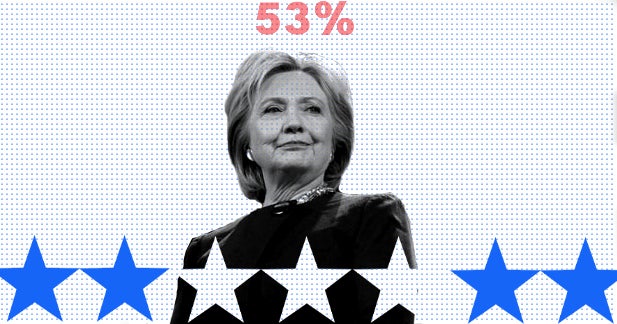
New research by the Pew shows a strong correlation between approval ratings and voter choice.
Since April, President Obama’s approval ratings have held steady between 50-54 percent rising slightly overall (latest numbers have the president at 53 percent.) With 47 days until the election, it’s fairly safe to say that these numbers will hold, and the president will close out his two terms somewhere in this range. This bodes well for Hillary Clinton.
A new study released today by the Pew Research Center found that approval ratings are a more accurate predictor of voter choice than overall satisfaction with the state of the country. The findings point out that satisfaction levels have been low since the waning days of the Clinton administration, and subsequent elections have proven that the relationship between voter choice and overall satisfaction is surprisingly low—especially when compared to voter choice/incumbent approval ratings.

Going back to 2000, of those who approved of the job Bill Clinton was doing when he prepared to leave office, 70 percent voted for Gore and only 23 percent voted for Bush. And 2008’s numbers are even more striking: of those who approved of George W. Bush, 84 percent voted for McCain, while only 9 percent voted for Obama. Now McCain lost soundly to Obama in 2008, but it’s worth noting that George W. Bush’s approval rating was a dismal (and record low) 22 percent when he left office. So the pool of approvers from which McCain drew from was quite low. Now Gore is a different story. Bill Clinton’s approval rating for December, 2012 was 63 percent—which is really high. And while Gore clearly benefited from this boost, and did win the popular vote, he was fighting against history a bit. In the modern, term limit era, beginning with Harry S. Truman, a political party has only held the White House for three consecutive terms once. Reagan’s two terms were followed up with a victory by George H.W. Bush. Of course, Bush ran against Michael Dukakis, an intelligent, but disconnected candidate who ran a stoic campaign full of gaffes and questionable decisions. So the ‘88 election is an outlier in more ways than one.
Clinton is up against the same three-term firewall as Gore was, and Obama’s farewell approval numbers are lower than Bill Clinton’s. So she may not get quite the incumbent boost that Gore received, but she isn’t up against the Bush machine, which helps. President George H.W. Bush may have only been a one term president, and his numbers bounced around a lot, but he did end up with a 60.9 percent approval rating, which is nothing to sneeze at. And the Bush family already had a foundation built, W. just needed to step up onto it. Hillary Clinton is up against a monster of another ilk entirely, something spawned in the upside-down—and, really, she should be grateful for it. According to the Pew, Clinton should grab around 77 percent of voters who approve of Obama, and Trump should garner only 4 percent. The swing here is much larger than the 2000 election: it’s a 73 point swing vs. a 47 point swing.
This is all good news for Clinton supporters, as the data points to a significant incumbent boost heading her way on election day. It’s a demographic she will need to fully mine to win, but there’s no reason to believe that won’t happen.
Originally published on TheOvergrown.com.

